How to Sign a Word Document Using a Digital Signature Certificate
Document signing isn’t just for PDFs. We’ll walk you through how to add a digital signature in Word using your document signing certificate on a Windows device
Let’s cut to the chase: You bought a document signing certificate and want to know how to digitally sign a Word document using it. Or, you haven’t bought one yet but are wondering how easy it is to use this type of certificate if you do.
Either way, we’re here to walk you through the process in the amount of time it takes to order from your favorite takeaway lunch joint.
Let’s hash it out.
How to Digitally Sign a Word Document Using a PKI Digital Certificate
Adding a digital signature to your Microsoft Office Word document isn’t hard once you know what you’re doing. We’re here to help. Follow the instructions below, and you’ll be signing Word documents in no time!
NOTE: Before signing your document, you’ll need to open your digital certificate’s secure hardware authentication client on your device. For DigiCert certificates, for example, this is the SafeNet Authentication Client. Otherwise, it won’t recognize your certificate and key.
- Add the digital signature. In the top navigation bar, click Insert > Signature Line (found under the Text group). Select Microsoft Office Signature Line to pull up the signature screen.
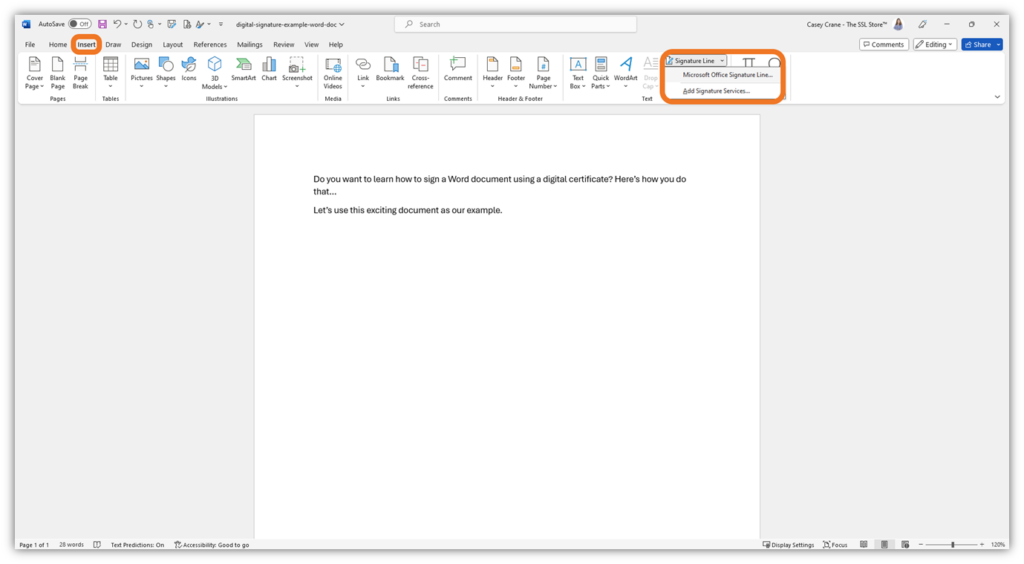
- Enter your personal info. Here, you’ll add your name, title, email address, and any instructions you want the signer to read. Hit OK.
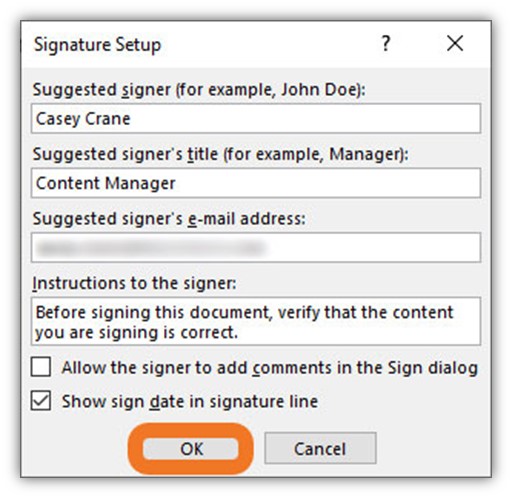
- Select your signing certificate. In this window, you’ll sign in the blank signature field next to the “X.” You can either print your name by double-clicking on the empty field and typing it in or create a handwritten signature using your cursor. (Optionally, you can select an image to insert using the Select Image dialog box, if you already have a signature image on file you’d prefer to use.)
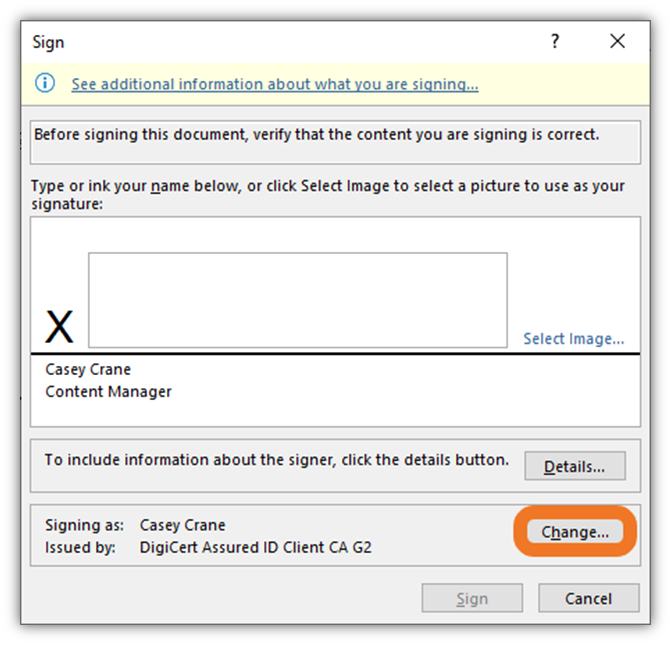
Once you’ve done that, review the “Signing as” information listed at the bottom (above the “Issued By” field). Hit Change to view the signing certificate. The certificate will display like this (see below).
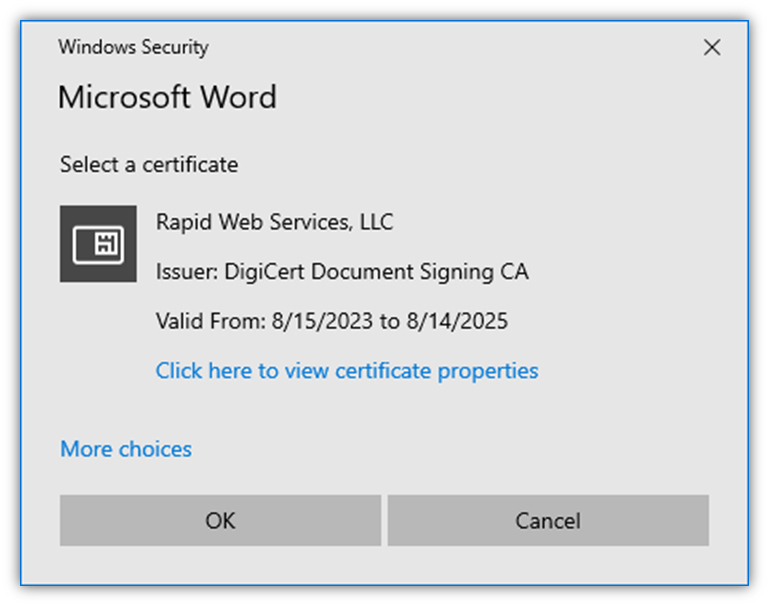
Select Click here to view certificate properties to inspect the certificate to ensure you have the correct one selected (if you have multiple digital certificates installed on your device).
If all looks good, hit OK and Sign back on the previous screen.
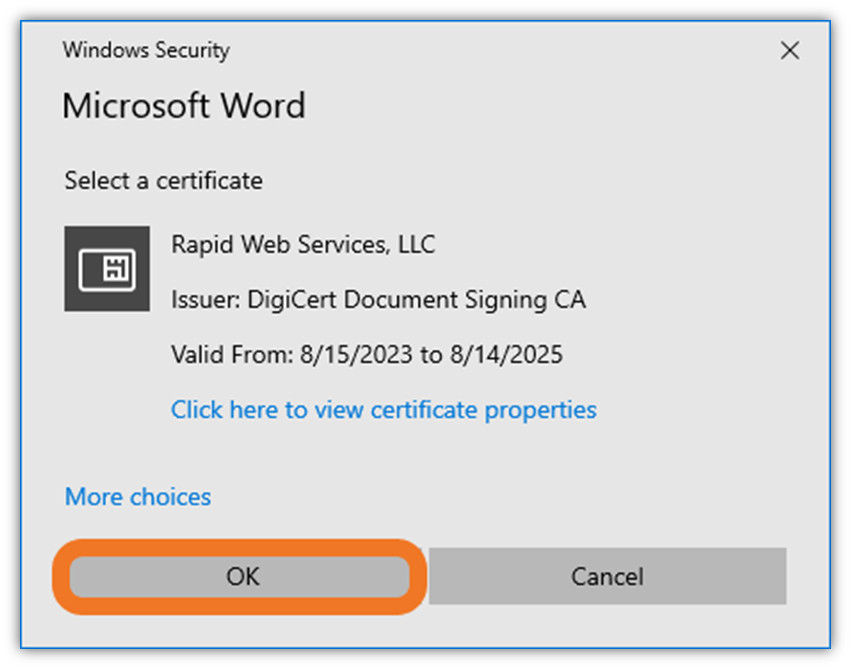
Otherwise, if it’s not the right certificate, you’ll need to select the right one by clicking on More choices. This will bring up a list of other valid digital certificates you have installed on your device.
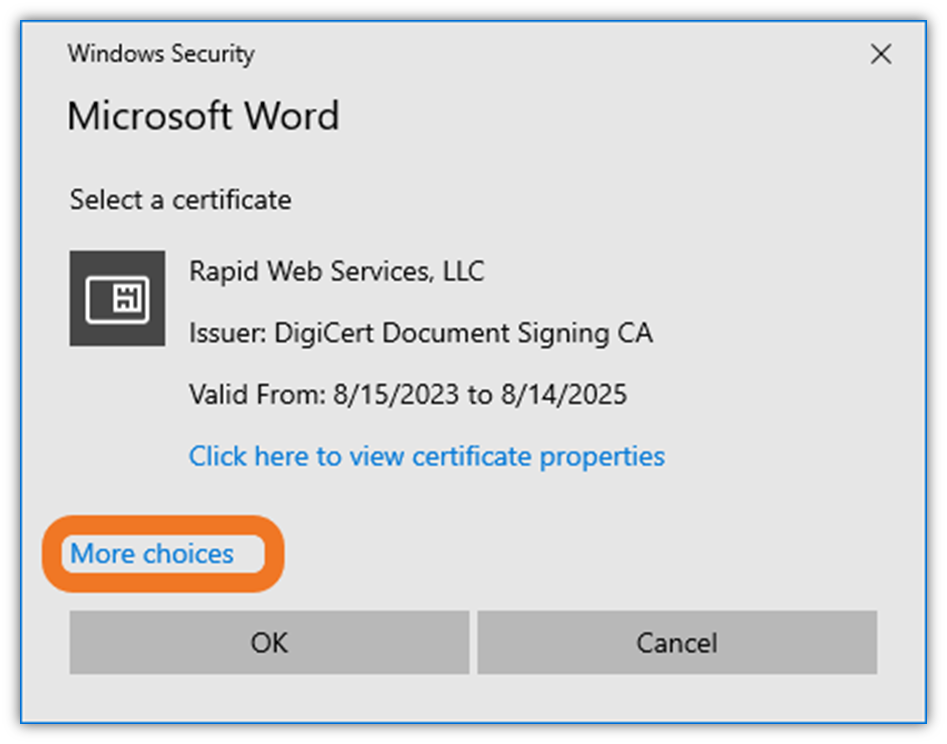
You can inspect each certificate in the same way by clicking on the selection in the list to display its details.
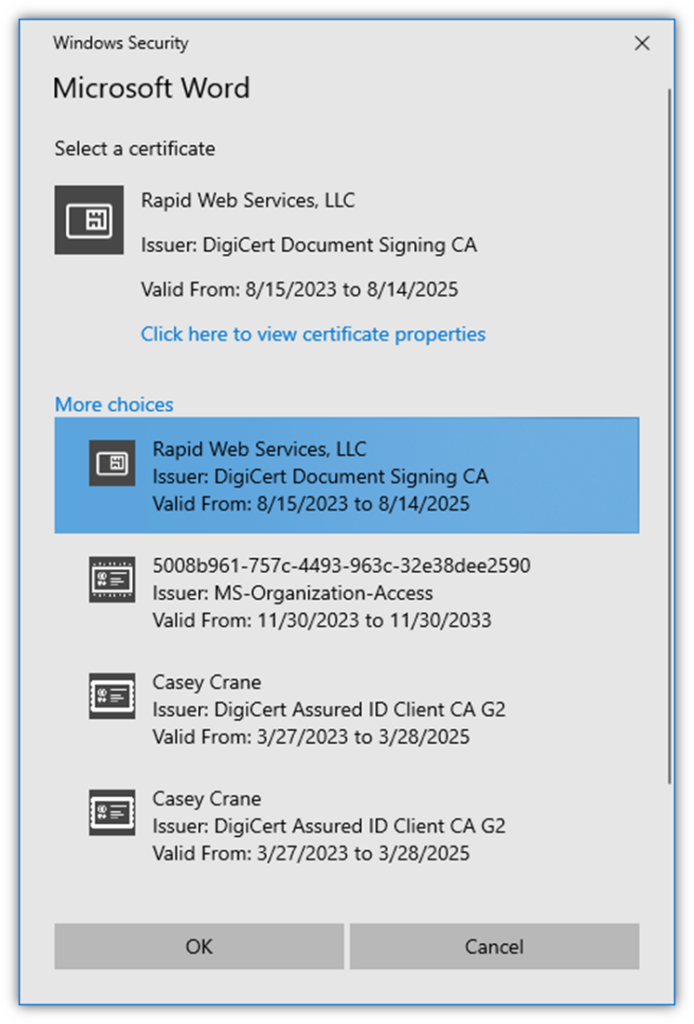
- Enter your authentication password. Once you’ve selected the right certificate, you’ll be prompted by your hardware certificate’s authentication client. In the example below, I’m using a DigiCert Document Signing Certificate, so it uses the SafeNet Authentication Client. Enter your password and hit OK.
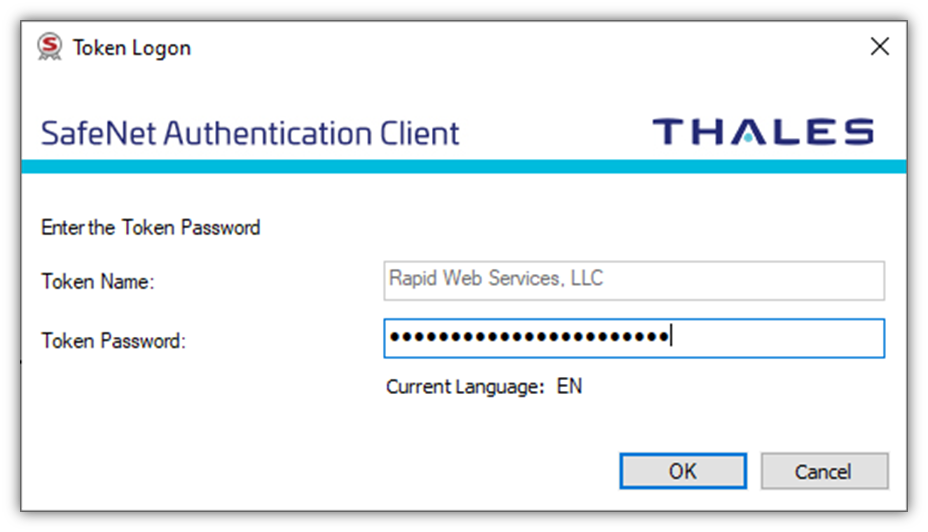
That’s it! Congratulations — you’ve officially learned how to sign a Word document using a digital certificate. If everything has gone according to plan, you should see the following message.
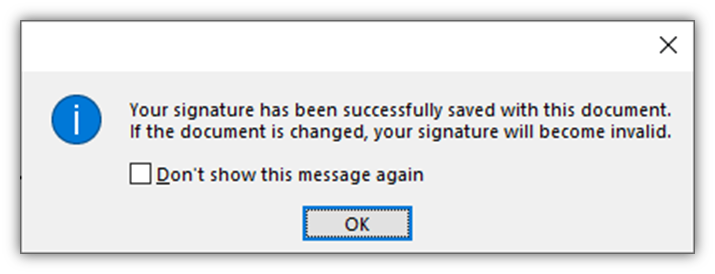
Now that you know how to sign a Word document using a document signing certificate, it’s time to take a look at how it’ll display to document users.
What Does a Signed Word Document Look Like?
Let’s take a quick peek at an example of a digitally signed Word doc (below).
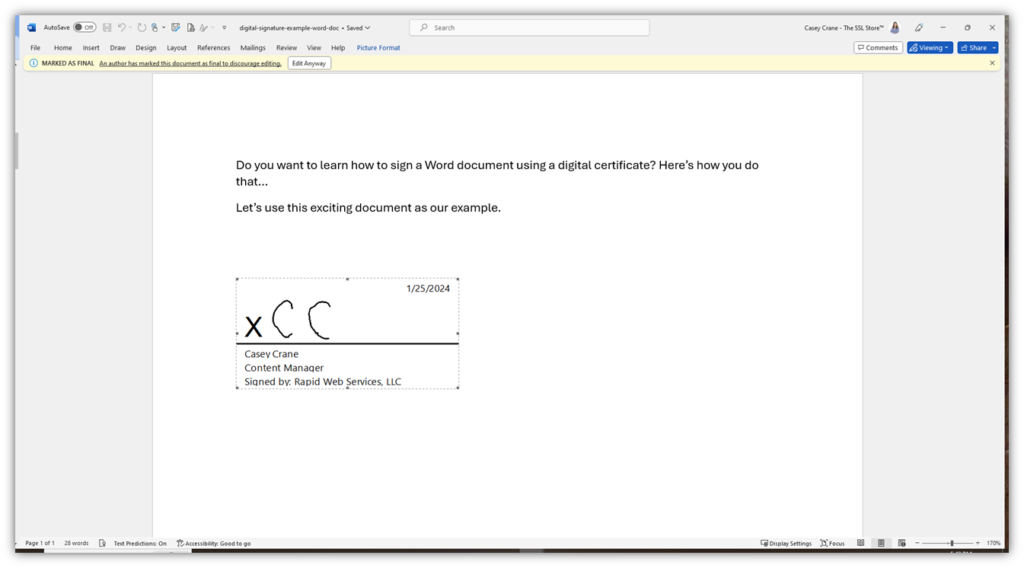
If you double-click on the signature block, it’ll display additional information:
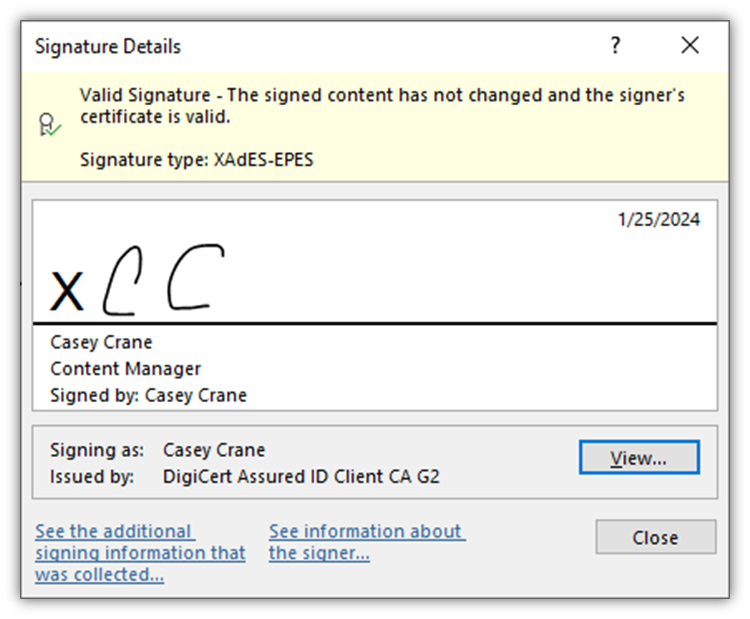
Here, you have multiple options:
- You can view the certificate’s details by hitting View. Here, you can flip through to read the certificate’s intended uses, who it was issued by, and who it was issued to. You can also click on the Certification Path to view the certificate’s trust chain (i.e., the intermediate and root certificate that it links back to through a verified process).
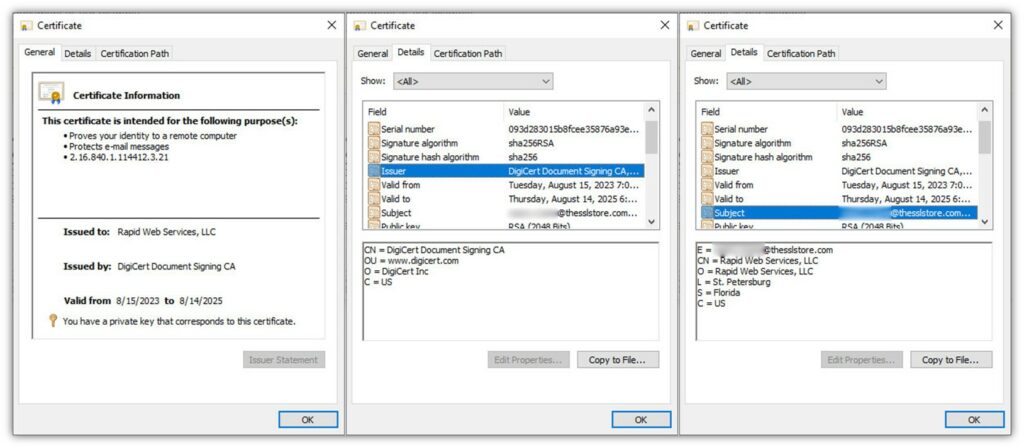
- You can see additional information collected during the signing process by clicking on the bottom-left link labeled “See the additional signing information that was collected…” This provides information about the versions of Windows, Microsoft Office and Word the signer was using, how many monitors the signer had connected to their device, the date and time when they signed, etc.
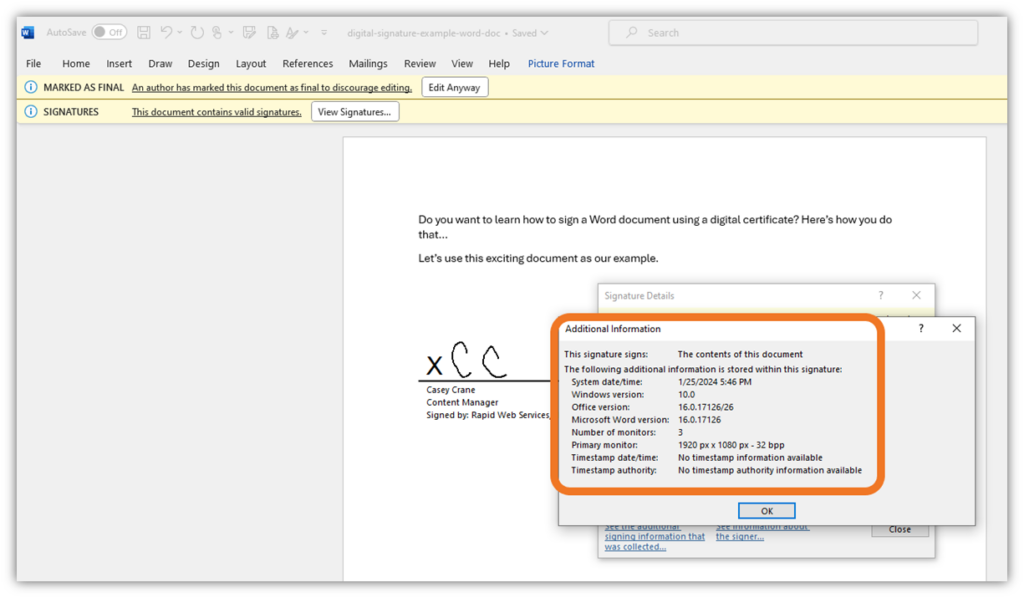
- Review additional information about the signer (if they entered those details) by clicking on the other corresponding link. This information could include their name, title, and address.
You can also access this signature information by selecting File > Info > Signed Document. This will bring up a right-hand vertical Signatures tab that you can use to view the document’s signature history. Simply select the signature you wish to view, click the drop-down arrow, and select Signature Details.
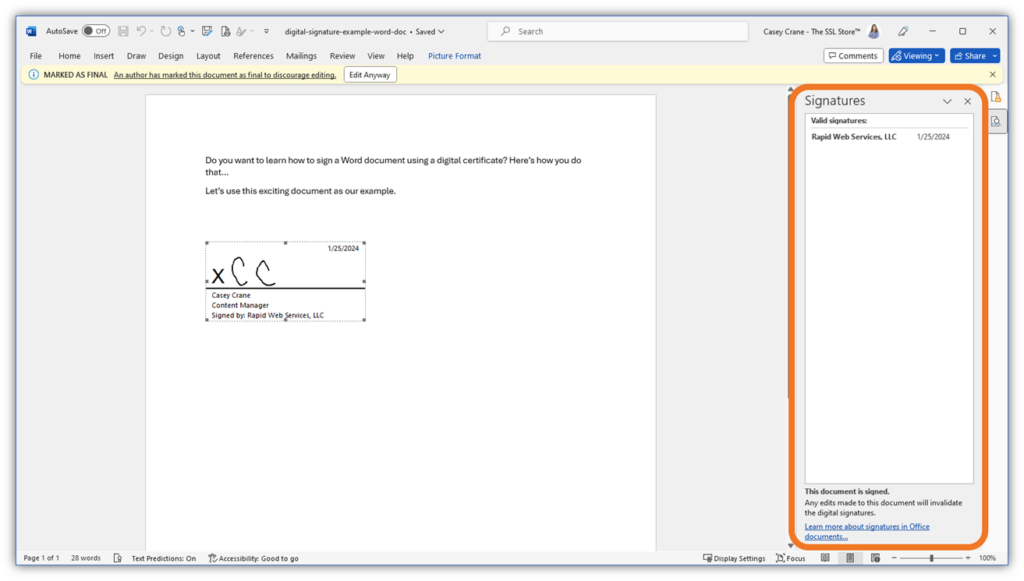
At the top of the document, you’ll notice a yellow warning line. This indicates that the document has been Marked as Final, which aims to discourage anyone from making changes to the document. If someone edits the document after the fact, it’ll remove the digital signature, indicating that the message has been altered since it was signed.

When this happens, when you switch back to the Signatures sidebar, you’ll see a request for a signature to be added to the document. It’ll state that the document isn’t signed:
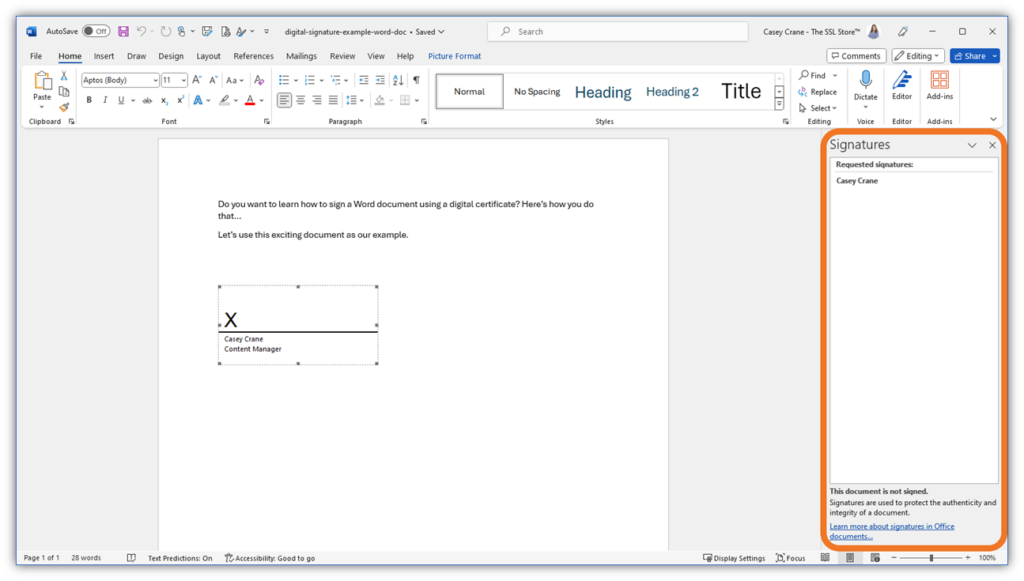
What Else Can Your Certificate Be Used to Sign?
Aside from Word documents, what else does a document signing certificate enable you to sign? This type of digital certificate enables you to sign Microsoft Office files:
- Microsoft Excel workbooks and spreadsheets
- Microsoft Office PowerPoint files
- LibreOffice and OpenOffice files
Some document signing certificates (e.g., DigiCert’s EV Document Signing Certificate) also allow you to use Adobe PDF documents. Want to learn more? We’ve provided a step-by-step guide on how to sign an Adobe PDF to learn more about how that process works.
Digital Signature vs Digital Certificate
Although the two are related, digital signatures and digital certificates aren’t synonymous.
A digital certificate is a small data file that can be used to create a digital signature. But as you’ll learn momentarily, the digital signature itself is the product of using specific cryptographic processes in combination with a digital certificate.
A digital signature is a type of electronic signature. And no, if you’re wondering, not all electronic signatures are digital signatures. If you’re unsure of the differences between electronic signatures and digital signatures, be sure to check out our article that breaks down digital signatures and why you should use them.
Your cryptographic key for your digital certificate will be issued on secure hardware (i.e., a secure USB token). The idea here is that it will help keep your private signing keys out of bad guys’ hands, so long as you follow secure key management best practices.
How Document Signing Works
We’ve already covered how digital signatures work extensively in another article. However, we’d be remiss if we didn’t at least provide a quick overview of the process:
- A cryptographic hash function is applied to the input data (e.g., a Word document).
- A cryptographic key is then applied to the resulting hash value (i.e., a random fixed-length string of data), encrypting it.
- This encrypted string of characters is combined with the key’s corresponding publicly trusted digital certificate to create the digital signature.
The following illustration provides a quick overview of what it looks like when you use a document signing certificate to add a digital signature to a Word document:
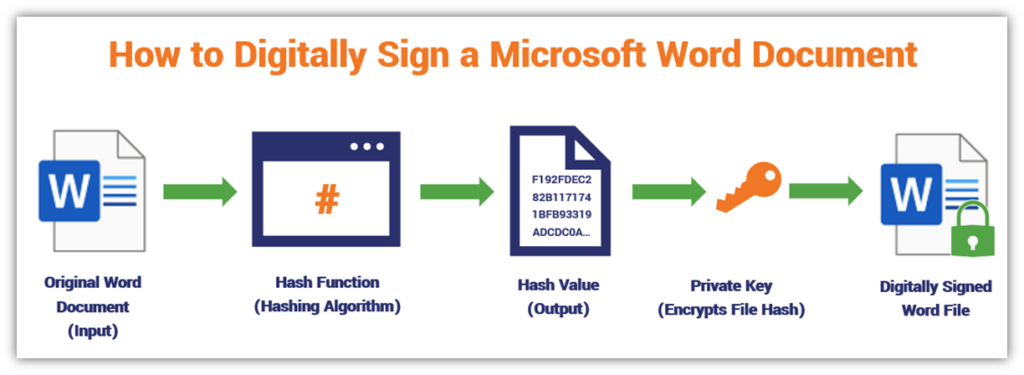
Image caption: An illustration of the PDF file-signing process.
Is Digitally Signing a Word Document Necessary?
Adding a digital signature to your Word files offers several important benefits:
- Unlike other e-signatures, digital signatures can’t be spoofed — it identifies the author of the signature with very high confidence.
- Using a digital signature assures the document recipient that the document/signature is from you.
- Signing your document with a digital signature also ensures that the document can’t be modified without the recipient knowing. (It’s all too easy to change a document’s meaning entirely by just changing a word or two!)
- Digital signatures help you achieve compliance with the U.S.’s Federal E-SIGN Act, the European Union’s eIDAS, as well as other international laws and regulations as far as legally binding electronic signatures are concerned.
We live in a time when Microsoft Word files are being weaponized to execute malware onto unsuspecting users’ devices remotely. So, having a way to differentiate real from tampered-with Microsoft Word files is crucial to helping your customers, employees, and other users make informed decisions.
Document signing is a great way to assert your digital identity on the documents you send. This cryptographic process helps to create digital trust, which bridges the gap between our physical and increasingly digital worlds.
Digital Trust Assures Users That You (and Your Docs) Are Real
Adding a digital signature to your Microsoft Word files is about using verified identity and cryptographic measures to offer assurance to users about the following:
- Authenticity: Your products (or documents, in this case), are legitimate.
- Data Integrity: The files haven’t been manipulated or altered since they were created and signed.
- Non-Repudiation: This shows users that you, as a verified individual, truly signed the document.
All of these things together help recipients of your Word doc know that your file is legitimate and can be trusted.
Word Document Signing Transcends Industries
Virtually every organization uses Office 365 or older versions of Microsoft Office products in some capacity. Document signing is beneficial for public and private organizations, having applications across many sectors, including:
- IT/cybersecurity
- Financial and investment institutions
- Medical and healthcare
- Legal
- Public services
Want to learn more about digital signatures and why they’re beneficial for businesses? Check out our article on when to use a digital signature certificate.






































![A Look at 30 Key Cyber Crime Statistics [2023 Data Update]](https://www.thesslstore.com/blog/wp-content/uploads/2022/02/cyber-crime-statistics-feature2-75x94.jpg)



















Be the first to comment